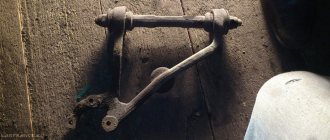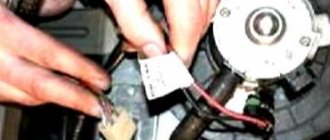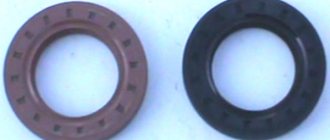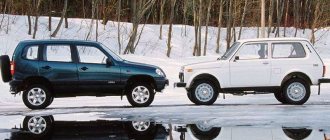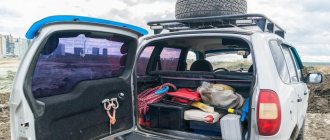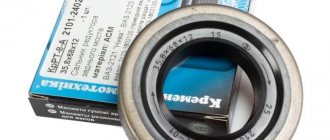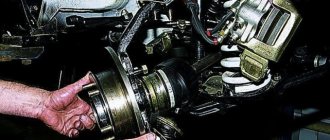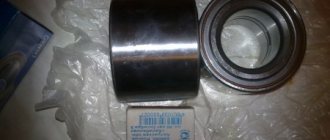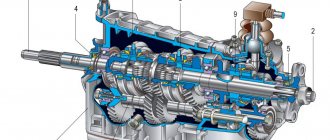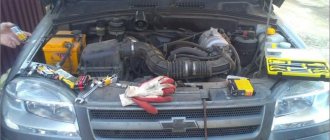What is a node
The name CV joint itself is an abbreviation for the phrase constant velocity joint.
The node faces the following tasks:
- Make the transmission of rotating torque from the engine to the wheels of the drive drive uniform and without loss of power.
- Reduce the load on expensive parts that rotate to move the car: shaft, gear, etc.
- Reducing the level of vibration when moving vehicles.
Modern front-wheel drive cars and some all-wheel drive “horses” are equipped with such homokinetic joints. The manufacturer guarantees the same duration of operation of the unit and the vehicle itself, provided that the CV joint is serviced and driven carefully. That is, if you drive carefully and periodically properly care for the part, it will last for the entire life of the vehicle.
The fulfillment of the first point depends only on the personality of the owner, his desire to monitor the technical and sanitary condition of the car. But the implementation of the second point on most domestic roads is sometimes simply impossible. And sooner or later the grenade (another name for the unit, which arose due to its external resemblance to a military projectile) fails. It is necessary to replace the internal or external CV joint on a Chevrolet Niva or on another car with a front-wheel drive and all-wheel drive design solution.
What is a CV joint?
Before front-wheel drive cars appeared, CV joints were not used as an option. As for the torque, it came to the wheels through the power unit. The driveshaft was also involved in this process. After front-wheel drive appeared, there was a need to update this mechanism, that is, it was very important that the wheels turn more easily.
Especially for this, specialists had to replace some elements, namely, develop a completely new part, which became known as a CV joint.
This abbreviation stands for constant velocity joint. Now it is this part that specialists use on front-wheel drive SUVs to transmit torque.
Many drivers also called this part a “grenade”. In appearance, the CV joint very much resembles it.
Varieties
SR as a suspension part began to be used on cars from the mid-20th century. Thanks to the unit, it became possible to simultaneously rotate and control the rotation of the wheels at an angle of up to 70 degrees. In the automotive industry, four technical solutions for components are used:
- cam;
- tripoid;
- ball;
- twin cardan shafts.
All these types are united by the basic design, which is a rigidly connected body and holder. The car's joints are also divided into:
- internal, rotating up to 20 degrees;
- external, more mobile and transmitting without power losses.
The part works according to the following principle.
- There are grooves on the surface of the inner race. Their number is the same as the number of bearings inside it.
- The cage is held in place by bearings that separate the housing and the cam.
- The bearings move along the path of the smaller diameter of the fist and the larger diameter of the housing.
- This creates a rotational impulse that transmits torque to the driven shaft.
If you change the angles connecting the axle shafts, the bearings begin to move inside the grooves. This is how torque is transmitted.
Reasons why a hinge joint fails
The internal CV joint on a Chevrolet Niva is a high-quality and reliable part of the automobile chassis system. Listed below are the main reasons that provoke early wear and failure of the unit.
- Incorrect, illiterate, extreme (rapid start with inversion of the drive drive and slipping) driving.
- Lack of care for a part that needs periodic cleaning and lubrication.
- Unfair production of the hinge assembly using low-quality materials and violation of technological rules.
Several signs listed below indicate that there may be a problem with the grenade and the internal CV joint on the Chevrolet Niva needs to be replaced.
- The appearance of a crunching sound when making turns. This phenomenon occurs if the SR requires lubrication of the connections, or a mechanical inclusion, for example, dirt, gets into it.
- Interruptions in the movement of the car at the start, when the speed increases or, conversely, when it decreases.
- Increased vibration when turning, accelerating, or driving at high speeds.
To make a final diagnosis, auto mechanics have created several simple techniques.
Front wheel drives Niva Chevrolet
Home • Niva • Chevrolet • Transmission
Chevy Niva front wheel drive: 1 – internal joint housing; 2 – clamp; 3 – clamp for securing the cover; 4 – wheel drive shaft; 5 – protective casing; 6 – protective cover; 7 – thrust ring of the cage; 8 – separator; 9 – clamp; 10 – ball; 11 – outer hinge cage; 12 – retaining ring; 13 – outer hinge body; 14 – clamp for fastening the casing. Torque is transmitted to the front wheels from the front axle gearbox through the right and left drives. Both drives are identical in design. Each drive consists of a shaft 4 and two joints of equal angular velocities installed on its splined ends. The internal joint housing 1 is connected to the side gear of the front axle reducer. The outer joint housing 13 is connected to the front wheel hub. The holder 11 is connected to the housing 13 through balls 10, which are located in the grooves of the housing and the holder. The race is installed on the splines of the shaft 4, rests against the ring 7 and is fixed on the shaft with a retaining ring 12. In the compressed state, this ring freely passes through the splined connection of the race 11, which allows you to both connect and separate the hinge and the shaft. The inner hinge body 1 differs from the outer hinge body 13 in that it has straight grooves.
Removal and installation of front-wheel drive Chevrolet Niva
To replace CV joints on a Chevy Niva, you will need a tool: 13, 17, 27 wrenches and a wrench for the wheel nuts.
Hang the car up and remove the front wheels, disconnect the front driveshaft from the front axle gearbox, disconnect the shock absorbers from the lower arms of the front suspension
Unscrew three nuts securing the bearing housings of the inner hinge of the right and left drives
Remove the bolt securing the right front axle gearbox bearing cover to the front suspension cross member
Unscrew the four nuts securing the front axle gearbox suspension brackets
Unscrew the nut and remove the bolt securing the left front axle gearbox bearing cover to the front suspension cross member
Raise the front axle gearbox and secure it in this position in any available way.
Remove the front wheel hub cap and unscrew the Niva Chevrolet hub nut
Remove the drive nut and centering sleeve
Compress the suspension spring by jacking up the lower arm. Unscrew the three nuts and remove the ball joint bolts from the lever
Move the steering knuckle to the side
Disconnect the exhaust pipe from the exhaust manifold and exhaust gas converter and take it to the engine (this operation is not required to remove the left drive)
Move the gearbox back and remove the front right drive of the Chevy Niva, and remove the left drive in the same way. Installation of the Niva Chevrolet front-wheel drive and all removed parts is performed in the reverse order of removal. When tightening the wheel hub nuts, adjust the play in the wheel bearings.
Dismantling and assembling front wheel drives of Niva Chevrolet (replacing the CV joint of the drive)
If you hear knocking noises in the front-wheel drive while driving when turning the car, check the constant velocity joints. If, when rocking the drive shaft by hand, play is felt or the dirt-proof covers are torn, such a hinge must be replaced. There is practically no point in disassembling the hinge. This is labor-intensive work, and if the cover is torn, dirt that has gotten into the hinge has already rendered the hinge parts unusable. The hinge parts cannot be replaced individually, and therefore the best option is to replace the hinge assembly, as well as its dirt-proof cover. As a last resort, disassembly is allowed to replace the grease of the internal joint as it is less susceptible to water and road dirt. The appearance of traces of grease on the hinge indicates that the cover is torn.
To replace CV joints on a Chevrolet Niva, you will need a screwdriver, sliding pliers and a hammer.
Using a screwdriver and sliding pliers, remove the large and small clamps from the inner joint cover
Slide the boot along the drive shaft
Knock the grenade off the shaft using a hammer and a wooden spacer, striking the end of the clip
To disassemble the inner hinge, use a screwdriver to pry off the retaining ring of the cage
Remove the cage assembly with separator and balls from the Chevy Niva hinge
Using a screwdriver and pliers, remove the large and small clamps of the outer CV joint boot casing
Slide the housing and boot along the drive shaft
Knock the joint off the shaft using a hammer and a wooden spacer, striking the end of the cage
Remove the cover and casing from the shaft and wash all metal parts with kerosene until the old grease is completely removed. Fill the CV joint with CV joint grease-4 (the amount of grease for the outer joint is 60 cm, for the inner joint - 150 cm). Install the grenade and the removed parts in the reverse order of removal.
Diagnostics
Experienced mechanics advise car owners to pay attention to the condition of the boots approximately every 5-7 thousand kilometers. Detection of any defects: cracks, failure of the clamp, indicates that the CV joint may be damaged. How can I check this?
- The car is placed on a lifting mechanism and engaged in first gear. A worn-out assembly will produce a sound resembling a characteristic crunching sound.
- An increase in play of one and a half tens of mm is a characteristic sign of failure. They check it by pumping the internal CV joint of the Chevrolet Niva at the output of the external drive.
You need to check the performance of the part periodically, every 4-5 months of driving on good roads. And every time after driving over rough terrain, dirt roads, potholes, etc.
Replacement procedure: step-by-step algorithm
There is no point in repairing a worn-out unit, so the outer CV joint of a Niva Chevrolet is always replaced. Replacing a damaged “grenade” is a labor-intensive operation. You will need a set of wrenches, pullers, and experience in performing plumbing work.
Outer CV joint
The damaged unit is replaced using an axle shaft with grenades removed from the vehicle. The body is raised with a car jack, a reliable stand under the car and wheel chocks are installed. This helps protect the repairman from possible injuries. Before lifting the car body, loosen the hub nut. You will need a head and an extension for the key. Next, you need to remove the wheel and unscrew the lower mount of the front shock absorber. Take it to the side and secure it with improvised means. Also unscrew the bolts on the ball joint.
Replacing the internal CV joint of a Niva Chevrolet
All parts of the unit are in constant motion during operation, as a result of which they wear out and fail. Therefore, most car owners are faced with the need to replace a faulty internal CV joint of a Chevrolet Niva with a serviceable one. Below is material for the step-by-step implementation of this work.
- The front of the car must be in an upright position. To ensure safety, it is necessary to place protective devices under it to ensure the immobility of the mechanism.
- At the very beginning you need to remove the wheel and the lower ball joint.
- Next, disconnect the shock absorber and the lower arm on the suspension, from which the spring is removed.
- The fist and hub are not removed, it is slightly hung to the side. To do this, you can adapt a generator belt or something similar.
- Then the cap and bearing nut are removed from the hub.
- The bolt that secures the right suspension bracket is unscrewed.
- At the assembly itself, you need to unscrew the nut and remove the grower, freeing up access to a larger threaded length. Using keys and a hammer, the SR is dismantled, removing it from the hub.
The hinge assembly on a Chevrolet is mounted in the reverse order.
Why can the CV joint on a Chevrolet Niva deteriorate?
Such parts tend to wear out, like all others, so they need to be replaced over time. Among the main reasons for which the CV joint will need to be replaced are the following:
- long service life of the outer CV joint - most often the part has to be replaced after 10 thousand kilometers;
- entry of dust or dirt when the rubber boot wears out (therefore you need to check the condition of the protective part).
In addition, a large load is placed on the Chevrolet Niva grenade when the steering wheel is turned at strong turns, and driving occurs on poor road surfaces.
Having become familiar with all the features of the hinges, an experienced driver will be able to correctly replace the outer CV joint for a Chevrolet Niva on his own.
